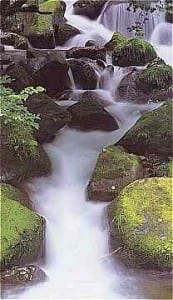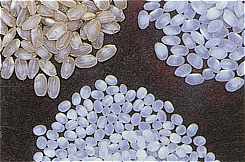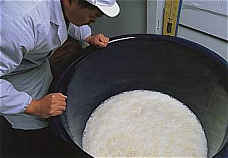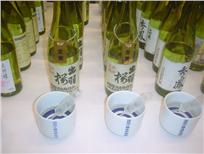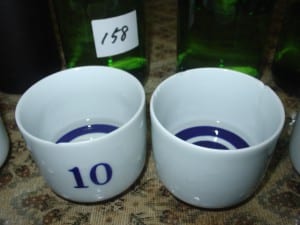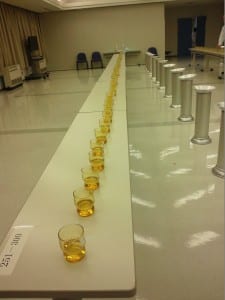What else makes your sake taste and smell as it does?
 In a previous post, we began talking about the “flavor elements of sake,” i.e. what things – ingredients, methods and “after-care” – combine in various ways to make the sake before you taste and smell the way it does. And last month we looked at the main ingredients and their contributions. Rice, water, yeast and koji all play their roles, and those roles are intertwined. If you missed that, you can check it out here.
In a previous post, we began talking about the “flavor elements of sake,” i.e. what things – ingredients, methods and “after-care” – combine in various ways to make the sake before you taste and smell the way it does. And last month we looked at the main ingredients and their contributions. Rice, water, yeast and koji all play their roles, and those roles are intertwined. If you missed that, you can check it out here.
This time around, let us consider the following brewing processes, the choice of which will alter the path a sake-in-waiting will tread. While there is potentially no end to the points would could consider, let us narrow it down to six: milling, yeast starter, pressing, pasteurization, whether or not added alcohol has been used, and aging.
And just like the ingredients side of things, none of these six processes have an absolutely guaranteed air-tight cause and effect relationship with the final sake. All are intertwined with the many other choices involved. But there are tendencies for sake made with these methods to end up tasting and smelling a certain way. So let us look at those admittedly tenuous-yet-valid connections.
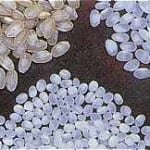 Milling
Milling
More than anything else, milling affects lightness: the more the rice is milled before brewing begins, the lighter and more refined the sake will be. But milling affects more than just the lightness as well – more highly milled rice can indirectly lead to more fruity aromas. And other things affect lightness or heaviness as well. But in general, the more you mill the rice, the lighter and more refined the sake will be.
This is because milling the rice more takes away increasingly more of the fat and protein lurking near the surface that lead to richer, fuller flavors.
Note that more milling is not always better, even though that point is used often in product marketing. Lighter sake is not unequivocally better than richer sake; not at all. And more milling does not guarantee a lighter sake. But the tendency is in fact there.
Yeast Starter
More than anything else, the choice of yeast starter affects flavor elements like sweetness, acidity and umami, expressed perhaps as “clean-ness versus richness.”
 This section could be expanded to fill several books, at least. But since we do not have that luxury now, let us break it down a bit. There are three main ways of preparing the yeast starter, a few less mainstream but very valid ways, and tons of variations beyond that.
This section could be expanded to fill several books, at least. But since we do not have that luxury now, let us break it down a bit. There are three main ways of preparing the yeast starter, a few less mainstream but very valid ways, and tons of variations beyond that.
What are those three main methods? Wincing at how inappropriate it is to constrain them to a single paragraph, they are: sokujo, kimoto and yamahai. Sokuju the most modern (yet still over a hundred years old), used to make 99 percent of all sake out there, and leads to clean sake.
Kimoto is the oldest and most traditional, very little is made, and leads to richer sake, often with a bright (almost tart) acidity and fine-grained flavor.
Yamahai is also about 100 years old and often yields richer, wilder sake with higher sweetness and acidity.
However, the above three descriptions are just tendencies, albeit solid ones to be sure. But not all yamahai is wild, not all kimoto is fine-grained, and not all sokujo is squeaky clean.
Note these three methods are also affected by everything else: milling, rice, yeast, water and more. The choice of yeast starter alone does not guarantee anything.
And the method chosen affects other things than the over-simplistic flavor profiles described above. But in short, the choice of yeast starter method affects clean-ness versus richness.
Pressing Method
More than anything else, the choice of pressing method affects expressiveness and intensity.
After a month-long fermentation period, the mash is pressed through a mesh, removing the remaining rice solids and sending the completed sake through. Not surprisingly there are a few main methods in use for this pressing step, and just as unsurprisingly they lead to different type of sake.
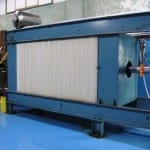 Machine press
Machine press
Most sake is pressed using a machine that does this very efficiently. The fermented mash is forced through mesh panels leaving the dregs clinging to the mesh and the golden ambrosia comes out the other end. This machine does a great job and saves untold amounts of labor.
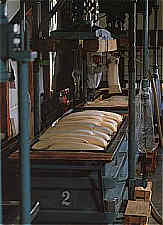 Fune (box press)
Fune (box press)
However, a brewer can perform this step in other ways too. One such method involves pouring several liters of the fermented mash into a meter-long cloth bag, and then piling those bags into a large, sturdy box maybe two-across, twenty-long, and ten-high – or thereabouts. The lid is then cranked down and into the box, and the sake comes out a hole in the bottom. Sake pressed in this method is usually called funa-shibori and is often more pronounced, expressive and aromatic.
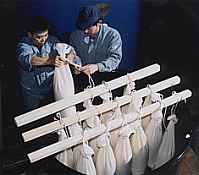 Shizuku
Shizuku
For those brewers and sake for which this is just not going far enough, the same bags o’ mash can be tied off and hung, and not squeezed at all. This drip-pressing method is called shizuku, And the sake that drips out is even more extravagantly aromatic, expressive and definitely intense.
However, many other things affect the expressiveness and intensity of a sake; the pressing method is just one of ‘em.
So in short, machine press – just fine; funashibori (box press) – more lively and aromatic; shizuku (drip press) – even more intense and expressive.
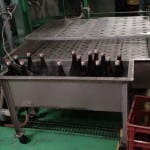 Pasteurization
Pasteurization
Most sake is pasteurized by heating it to about 60C or so for a short time. This stabilizes the product by killing off lactic bacteria and stifling enzymes that would otherwise feed those bacteria. When sake is not pasteurized it is called nama-zake, and is a very different animal.
Nama-zake can be livelier and more vibrant, often with more pronounced characteristic aromas. These aromas may be woody at first, and cheesy if the sake is not kept cold and away from oxygen.
While many find properly cared for nama to be more appealing, it is not unequivocally better – just different. Furthermore, nama-zake will mature much more quickly than pasteurized sake.
So, in short, nama is usually livelier in aromas, and pasteurized sake more settled and deep. But of course, there are exceptions.
Junmai vs. Jon-Junmai
Junmai means the sake was made with rice, water and koji only. If the junmai word is not on the bottle, then a bit of distilled alcohol has been added just after fermentation and before pressing to help extract more flavor and aroma, lighten the sake a bit, and improve shelf life as well. (Admittedly, in cheap sake lots is added to stretch yields, but in premium stuff this is neither the goal nor the result.)
Junmai types are often richer and fuller, especially compared to their non-junmai counterparts. So junmai ginjo is richer than (added-alcohol) ginjo, and junmai daiginjo is richer than (added-alcohol) daiginjo. Unless it isn’t.
Sometimes, that is simply not the case, and many people cannot tell the difference in most situations.
Ergo, in a nutshell, junmai types are slightly richer than added alcohol types. Usually.
 Aging
Aging
This is the simplest of the method-related generalizations here: aged sake takes on color, a sherry-like quality, earthiness and more pronounced flavors. Many factors affect this: the milling of the original sake, whether it is junmai or added-alcohol, time, temperature and vessel.
But in its simplest form, the more mature a sake is, the more intense and sherry-like its flavors and aromas become – most of the time, that is.
Most sake is shipped and meant to be consumed young: within a year or two. Very, very little is aged for more than a couple of years. While that rabbit hole, too, is deep, fascinating and enjoyable, it is a very small part of the market for now.
Along with last month’s assessment of the main ingredients of sake, the above runs down a few of the many options a brewer has in making sake, and how those choice will more than likely – but not absolutely – affect the fine nature of the sake. A quick review of the last line in each section should suffice as a quick-n-simple assessment of how each step affects the final product, and should hopefully be useful in knowing why your sake tastes the way it does, or what to expect based on the info on the label.
But superseding this all is the warm-n-fuzzy elusive nature of sake. As soon as we think we got it figured out, it hoses our hubris. And therein lies the fun.
~~~~~~~~~~~~~~~~~~~~~~~~~~~~~~~~~~~~~~~~~~~~~~~~~~~
 Fond of doing things at the last minute? Then check out the Sake Professional Course to be held in Toronto October 3, 4 and 5. Learn more here.
Fond of doing things at the last minute? Then check out the Sake Professional Course to be held in Toronto October 3, 4 and 5. Learn more here.
 Sake is booming; it is growing strongly in popularity both inside Japan and around the world. And while this is true, we still have a long way to go. In an effort to curb I.S.E. (irrational sake exuberance), here are some sobering statistics that will encourage us to drink more sake and to promote it actively.
Sake is booming; it is growing strongly in popularity both inside Japan and around the world. And while this is true, we still have a long way to go. In an effort to curb I.S.E. (irrational sake exuberance), here are some sobering statistics that will encourage us to drink more sake and to promote it actively. Only 3.2 percent of all sake made is exported
Only 3.2 percent of all sake made is exported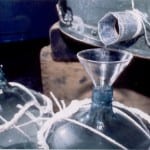 Sixty percent of all sake breweries are small to mid-sized companies, of which half are either losing money or barely (i.e. insignificantly) profitable.
Sixty percent of all sake breweries are small to mid-sized companies, of which half are either losing money or barely (i.e. insignificantly) profitable.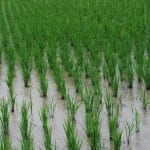 A quarter of a million tons. The fact that only thirty six percent was proper sake rice is not disconcerting at all, since so much non premium sake is made – it is still 65 percent of the market. So the numbers are just about right, even if a bit inconceivably large in scale.
A quarter of a million tons. The fact that only thirty six percent was proper sake rice is not disconcerting at all, since so much non premium sake is made – it is still 65 percent of the market. So the numbers are just about right, even if a bit inconceivably large in scale.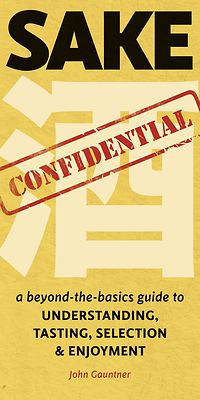





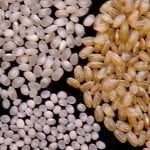 Sake is, as we all know, brewed from rice. Rice, in turn, is a very focused expression of soil, climate, and each year’s weather conditions such as sunshine, rain and typhoons. Every growing season is different, and there are good years for sake rice and bad years for sake rice.
Sake is, as we all know, brewed from rice. Rice, in turn, is a very focused expression of soil, climate, and each year’s weather conditions such as sunshine, rain and typhoons. Every growing season is different, and there are good years for sake rice and bad years for sake rice.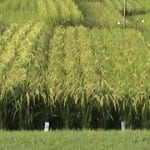 Wouldn’t it be great if someone analyzed it for them? Sure, brewers might know the weather of their immediate vicinity. But since rice can be brought in from other regions, wouldn’t it be great if the brewers could learn what to expect from each season’s rice, each of the main varieties of rice, from each region of Japan? Then they could use such data to determine how to tweak their brewing methods to adapt to each year’s and each region’s rice.
Wouldn’t it be great if someone analyzed it for them? Sure, brewers might know the weather of their immediate vicinity. But since rice can be brought in from other regions, wouldn’t it be great if the brewers could learn what to expect from each season’s rice, each of the main varieties of rice, from each region of Japan? Then they could use such data to determine how to tweak their brewing methods to adapt to each year’s and each region’s rice. Then, it waxes technical. It explains in excruciating detail how higher averages temperatures lead to longer Amylopectin (one of the two components of starch) chains. This means that the starches will dissolve very easily in the moromi (fermenting mash), which means more flavorful sake if controlled, but big-assed sloppy flavors if not reined in. It also accordingly means that resulting sake will be more susceptible to aging the adverse effects of aging.
Then, it waxes technical. It explains in excruciating detail how higher averages temperatures lead to longer Amylopectin (one of the two components of starch) chains. This means that the starches will dissolve very easily in the moromi (fermenting mash), which means more flavorful sake if controlled, but big-assed sloppy flavors if not reined in. It also accordingly means that resulting sake will be more susceptible to aging the adverse effects of aging.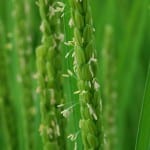 Summer in Japan this year was again hot, just about as hot as last year was. The warmer temperatures of the past decade and then some have continued. Furthermore, the islands of Japan were pummeled with typhoons this fall, meaning lots and lots of rain. Factoring in all that and more, the prognosis was that this year’s rice will be not dissolve very well; not too bad, mind you. Just not so well.
Summer in Japan this year was again hot, just about as hot as last year was. The warmer temperatures of the past decade and then some have continued. Furthermore, the islands of Japan were pummeled with typhoons this fall, meaning lots and lots of rain. Factoring in all that and more, the prognosis was that this year’s rice will be not dissolve very well; not too bad, mind you. Just not so well.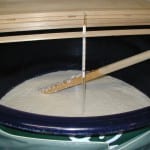 That’s the cool thing about sake: in making it, we can meet nature half-way. What will most noticeably suffer are the highest grades of sake, contest sake especially. But for most of us, what we will be drinking will be as good as it usually is; but we should not forget that added burden that will be on rice farmers and brewers to make it that way. Sake, like wine, remains an integral expression of nature.
That’s the cool thing about sake: in making it, we can meet nature half-way. What will most noticeably suffer are the highest grades of sake, contest sake especially. But for most of us, what we will be drinking will be as good as it usually is; but we should not forget that added burden that will be on rice farmers and brewers to make it that way. Sake, like wine, remains an integral expression of nature.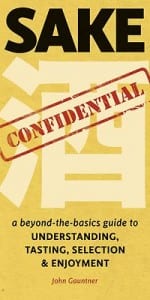
 The main raw materials of sake are rice and water, and rice is the only fermentable material used in its production. And just as the grapes used to make good wine are significantly different from those bought at the supermarket, the rice used to make premium sake is significantly different from that which we find sitting under the fish in sushi, or in bowls in meals.
The main raw materials of sake are rice and water, and rice is the only fermentable material used in its production. And just as the grapes used to make good wine are significantly different from those bought at the supermarket, the rice used to make premium sake is significantly different from that which we find sitting under the fish in sushi, or in bowls in meals. In proper sake rice, the higher-than-normal starch content is mostly concentrated in the center of the grains. Why is this so heart-warmingly special? Because we want to get at the starch, which will be converted to sugar and then into alcohol. But we don’t want the fat and protein, which would lead to off-flavors and contribute rough elements to the sake. So with the starch neatly concentrated in the center, all we need to do is to mill away more and more of the outside of the grain, and by doing that we remove the fat and protein and leave only the starchy goodies behind.
In proper sake rice, the higher-than-normal starch content is mostly concentrated in the center of the grains. Why is this so heart-warmingly special? Because we want to get at the starch, which will be converted to sugar and then into alcohol. But we don’t want the fat and protein, which would lead to off-flavors and contribute rough elements to the sake. So with the starch neatly concentrated in the center, all we need to do is to mill away more and more of the outside of the grain, and by doing that we remove the fat and protein and leave only the starchy goodies behind.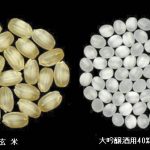 Why does sake rice have the starch in the center, and fat and protein around that? Part of it is just the nature of those strains. But it also has to do with climate and growing conditions. Regions with hot days and cold nights are best for sake rice production, as the cold nights coerce the plant to send the starch to the center of the grains. In “bad years” for rice, seasons being too hot or too cold, too wet or too dry, or when the night and day temperatures had less variance, fewer grains will have a decent shinpaku.
Why does sake rice have the starch in the center, and fat and protein around that? Part of it is just the nature of those strains. But it also has to do with climate and growing conditions. Regions with hot days and cold nights are best for sake rice production, as the cold nights coerce the plant to send the starch to the center of the grains. In “bad years” for rice, seasons being too hot or too cold, too wet or too dry, or when the night and day temperatures had less variance, fewer grains will have a decent shinpaku.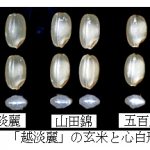 Note, too, that one can make decent-to-good sake from regular rice. It takes a good toji and good tools, but just a few of the many examples of table rice from which decent sake is brewed are Koshihikari, Sasanishiki, the illustrious Kame no O. So one can indeed make decent sake from table rice. It’s just easier to do so with real sake rice.
Note, too, that one can make decent-to-good sake from regular rice. It takes a good toji and good tools, but just a few of the many examples of table rice from which decent sake is brewed are Koshihikari, Sasanishiki, the illustrious Kame no O. So one can indeed make decent sake from table rice. It’s just easier to do so with real sake rice.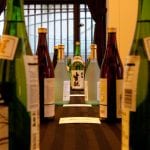 The Sake Professional Course in Japan is far and away the best possible sake education in existence. Three days of lecture and tasting, each evening capped off with dinner and fine, fine sake, followed by two days spent visiting four sake breweries of different size and scale – punctuated again with fine sake and a great meal each evening make this course as comprehensive as it could be. If you are serious about sake, and especially about working with sake, there is no other course for you; this is it. Satisfaction is guaranteed.
The Sake Professional Course in Japan is far and away the best possible sake education in existence. Three days of lecture and tasting, each evening capped off with dinner and fine, fine sake, followed by two days spent visiting four sake breweries of different size and scale – punctuated again with fine sake and a great meal each evening make this course as comprehensive as it could be. If you are serious about sake, and especially about working with sake, there is no other course for you; this is it. Satisfaction is guaranteed. The course will be held from the morning of Tuesday, January 10 to the evening of Saturday, January 14,2017, and will be focused in Tokyo, but with a two- day excursion to the Osaka – Kyoto – Kobe area to visit four sake breweries of various scale. Geared toward professionals, but open to anyone with an interest in sake, this course will begin with the basics, and will provide the environment for a focused, intense, and concerted training period. It will consist of classroom sessions on all things sake-related, followed by relevant tasting sessions, four sake brewery visits, and exposure to countless brands and styles in several settings, both in comparison to other sake, and with food. Participants will stay together at hotels in Tokyo and Osaka. Lectures will take place in a comfortable classroom, and evening meals will be off-site at various sake- related establishments.
The course will be held from the morning of Tuesday, January 10 to the evening of Saturday, January 14,2017, and will be focused in Tokyo, but with a two- day excursion to the Osaka – Kyoto – Kobe area to visit four sake breweries of various scale. Geared toward professionals, but open to anyone with an interest in sake, this course will begin with the basics, and will provide the environment for a focused, intense, and concerted training period. It will consist of classroom sessions on all things sake-related, followed by relevant tasting sessions, four sake brewery visits, and exposure to countless brands and styles in several settings, both in comparison to other sake, and with food. Participants will stay together at hotels in Tokyo and Osaka. Lectures will take place in a comfortable classroom, and evening meals will be off-site at various sake- related establishments. The cost for this five-day educational experience is ¥190,000. This includes all instruction and materials, as well as evening meals with plenty of sake each night. Other meals, transportation to and from as well as within Japan, and hotel are not included in the tuition. To make a reservation or if you have any questions at all, please send an email to John Gauntner at sakeguy@gol.com .
The cost for this five-day educational experience is ¥190,000. This includes all instruction and materials, as well as evening meals with plenty of sake each night. Other meals, transportation to and from as well as within Japan, and hotel are not included in the tuition. To make a reservation or if you have any questions at all, please send an email to John Gauntner at sakeguy@gol.com .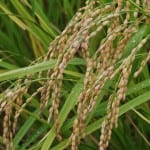 In the April issue of blog, archived
In the April issue of blog, archived 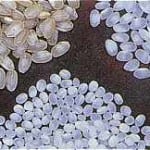 Before launching into its history and roots, let’s quickly review why it is significantly easier to make good sake using Yamada Nishiki. The grains are large, which means more potential for fermentable starch inside. The starches are concentrated in a ball of starch in the middle, and well centered, meaning it is easy to mill the outer fat and protein away, revealing only the starch. And, that protein and fat are at low levels to begin with, lowering the potential for off-flavors.
Before launching into its history and roots, let’s quickly review why it is significantly easier to make good sake using Yamada Nishiki. The grains are large, which means more potential for fermentable starch inside. The starches are concentrated in a ball of starch in the middle, and well centered, meaning it is easy to mill the outer fat and protein away, revealing only the starch. And, that protein and fat are at low levels to begin with, lowering the potential for off-flavors.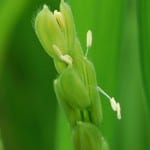 But after that change, tax was due in money based on the amount of land they owned. This means that all of a sudden rice was a commodity, a product to be sold on the marketplace that would lead to revenue to pay such taxes and cover living expenses and savings. As such, the more one grew the more one made, and farmers were all of a sudden very motivated to maximize yields and to do that by growing high-yield rice varieties. Sake rice varieties are decidedly not that kind of rice. So, even though demand for rice was increasing, the production of sake rice with its low yields began do prodigiously drop.
But after that change, tax was due in money based on the amount of land they owned. This means that all of a sudden rice was a commodity, a product to be sold on the marketplace that would lead to revenue to pay such taxes and cover living expenses and savings. As such, the more one grew the more one made, and farmers were all of a sudden very motivated to maximize yields and to do that by growing high-yield rice varieties. Sake rice varieties are decidedly not that kind of rice. So, even though demand for rice was increasing, the production of sake rice with its low yields began do prodigiously drop.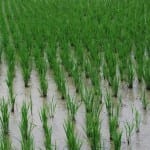 These are then grown to yield more seeds, which are then grown to yield even more seeds, that are then distributed to seed cooperatives, who then distribute the seeds to the farmers to use to grow the rice. So count ‘em: that is only three generations from purity each year, no seeds are any more than three generations from individually inspected and assessed purity. Dig that.
These are then grown to yield more seeds, which are then grown to yield even more seeds, that are then distributed to seed cooperatives, who then distribute the seeds to the farmers to use to grow the rice. So count ‘em: that is only three generations from purity each year, no seeds are any more than three generations from individually inspected and assessed purity. Dig that.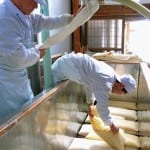 More information about the course, the schedule, the syllabus and the fun is available
More information about the course, the schedule, the syllabus and the fun is available  The government in Japan, in particular the National Tax Administration, monitors trends in sake preferences amongst consumers, as expressed by trends in sake production. The results of the analysis of data from last year’s sake was released a short while ago. While it is nothing shocking, it is interesting to see how things change. Here are a couple of tendencies culled from that slurry of data.
The government in Japan, in particular the National Tax Administration, monitors trends in sake preferences amongst consumers, as expressed by trends in sake production. The results of the analysis of data from last year’s sake was released a short while ago. While it is nothing shocking, it is interesting to see how things change. Here are a couple of tendencies culled from that slurry of data.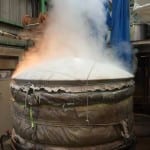 Again, hardly surprising, but the level of the ester ethyl caproate, which leads to aromas like ripe apple, tropical fruit and licorice or anise, has been on the increase. Curse it. This is hardly surprising considering that ginjo and daiginjo continue to grow very strongly in popularity.
Again, hardly surprising, but the level of the ester ethyl caproate, which leads to aromas like ripe apple, tropical fruit and licorice or anise, has been on the increase. Curse it. This is hardly surprising considering that ginjo and daiginjo continue to grow very strongly in popularity. Non-premium sake has seen a decrease in alcohol content overall. Ginjo et cetera has seen alcohol levels stay fairly high, likely for increased impact, but in non-premium futsuu-shu alcohol has dropped a bit on the average. I am not sure what the significance of this point is, though, nor was it elucidated upon in the government report.
Non-premium sake has seen a decrease in alcohol content overall. Ginjo et cetera has seen alcohol levels stay fairly high, likely for increased impact, but in non-premium futsuu-shu alcohol has dropped a bit on the average. I am not sure what the significance of this point is, though, nor was it elucidated upon in the government report. Milling
Milling This section could be expanded to fill several books, at least. But since we do not have that luxury now, let us break it down a bit. There are three main ways of preparing the yeast starter, a few less mainstream but very valid ways, and tons of variations beyond that.
This section could be expanded to fill several books, at least. But since we do not have that luxury now, let us break it down a bit. There are three main ways of preparing the yeast starter, a few less mainstream but very valid ways, and tons of variations beyond that. Machine press
Machine press Fune (box press)
Fune (box press) Shizuku
Shizuku Pasteurization
Pasteurization Fond of doing things at the last minute? Then check out the Sake Professional Course to be held in Toronto October 3, 4 and 5. Learn more
Fond of doing things at the last minute? Then check out the Sake Professional Course to be held in Toronto October 3, 4 and 5. Learn more 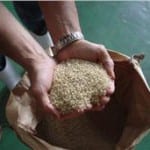 I. Rice = Flavor
I. Rice = Flavor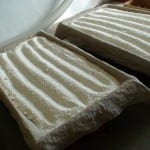 Koji provides enzymes that convert starch to sugar. Just how strong those enzymes are, and at what stage of the brewing process they are most active, will determine how sweet or dry the sake is. If the koji leads to lots of starch-to-sugar conversion early on, that sugar will be readily converted to alcohol leading to a dry sake. If sugar comes along later in the process when the yeast is petering out, it will remain in the sake and lead to sweetness. In truth, this too is more complicated. But therein lies the gist.
Koji provides enzymes that convert starch to sugar. Just how strong those enzymes are, and at what stage of the brewing process they are most active, will determine how sweet or dry the sake is. If the koji leads to lots of starch-to-sugar conversion early on, that sugar will be readily converted to alcohol leading to a dry sake. If sugar comes along later in the process when the yeast is petering out, it will remain in the sake and lead to sweetness. In truth, this too is more complicated. But therein lies the gist.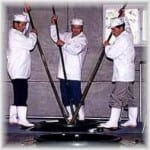
 York
York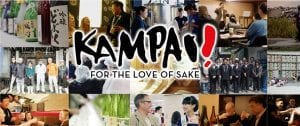 While it focuses on the paths of the three of us, a couple-few more people make appearances, including Haruo Matsuzaki, the “sake palate from you-know-where” industry consultant, and Daisuke Suzuki of Suzuki Shuzoten, brewers of Iwaki Kotobuki, who had to leave their kura in Fukushima due all that happened on March 11, 2011, are are now located in Yamagata.
While it focuses on the paths of the three of us, a couple-few more people make appearances, including Haruo Matsuzaki, the “sake palate from you-know-where” industry consultant, and Daisuke Suzuki of Suzuki Shuzoten, brewers of Iwaki Kotobuki, who had to leave their kura in Fukushima due all that happened on March 11, 2011, are are now located in Yamagata.